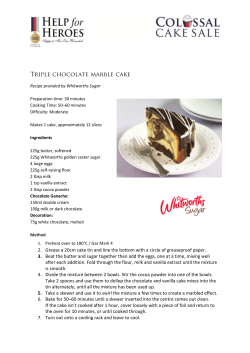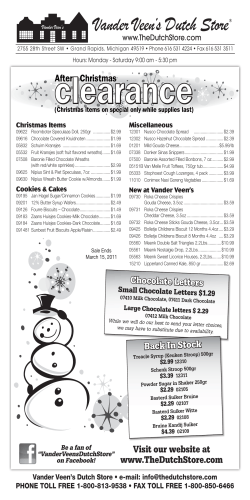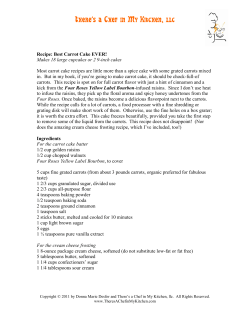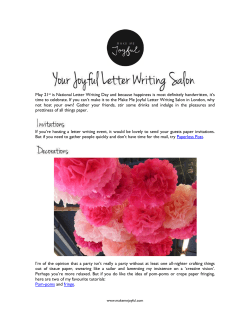
Document 80300
SW_VER_E1_290908_p11 C M Y K The Star 11 angela day MONDAY SEPTEMBER 29 2008 verve feedback E-mail [email protected] SMS 32546 (Each SMS costs R1) Baked cheesecakes are regarded as superior to fridge ones but they have a reputation for being temperamental. Angela Day shares her secrets to give a professional finish to these four decadent recipes THE JOY O F BAKIN G Part 8 CHOCOLATE CHEESECAKE FOR A LUSCIOUS DESSERT, JUST SAY ... BASIC CHEESECAKE WITH GRANADILLA TOPPING 250g Marie biscuits, crushed 125g butter, melted 500g thick cream cheese 100ml castor sugar 15ml grated lime or lemon rind 30ml freshly squeezed lime or lemon juice 2 eggs, lightly beaten 1 egg yolks Topping: 1 can granadilla pulp 2ml cornflour mixed with a little water whipped cream CHEESECAKE Step by step pictures from Australian Women’s weekly STEP 1: 1 200g chocolate digestive biscuits, crushed 80g butter, melted 750g thick cream cheese 250ml castor sugar 100g good quality dark chocolate, melted 3 extra large eggs, lightly beaten 2 egg yolks 30ml lemon or lime juice chocolate collar: 50g white chocolate, melted 100g dark chocolate, melted Wrap a double layer of foil on the outside of 20cm cake pan. (This is to prevent water from seeping in during baking.) Combine biscuit crumbs and butter together, press into the lightly greased pan. Chill in fridge. Beat the cream cheese until smooth, and then add the sugar. Add cooled melted chocolate. Beat in the eggs and egg yolks, then finally the lime/ lemon juice. Do not overbeat. Pour the cream cheese filling onto the chilled biscuit base, place the tin in a roasting pan and pour hot water around the foil-wrapped cheesecake to come about halfway up the sides. Bake at 170°C for about 50-60 minutes or until set. The cheesecake is ready when the mixture has set but still has a slight wobble. Remove cheesecake from the oven and carefully peel off foil covering. Leave to cool. Chill in fridge overnight. Remove from cake pan and transfer to a cake board. To make the chocolate collar, measure the height and length of the cheesecake. Cut a strip of nonstick baking paper the width and length of the cake. Spoon white chocolate into a piping bag with a small hole at the tip and pipe a pattern along the paper. Allow to set. Then spread cooled dark chocolate over the entire strip of paper. Allow chocolate to partially set before wrapping around the sides of the cheesecake with the chocolate on the inside. Seal ends, and hold the paper in place until the chocolate sets completely. Peel off the paper, leaving the chocolate pressed against the sides of the cheesecake. Transfer to a serving plate and decorate with grated chocolate and whipped cream. PICTURES: SHAYNE ROBINSON AND STEVE LAWRENCE SECRETS FOR A FLAWLESS FINISH Combine the biscuits and butter together, press neatly on to base and halfway up the sides of a lightly-greased, 20cm spring-form cake pan. Chill in fridge. BAKLAVA CHEESECAKE STEP 2: 2 Using an electric beater, beat the cream cheese and sugar together in a large bowl until smooth. Add lime rind and juice, mix well. Beat in eggs. Do not overbeat. STEP 3: 3 Pour mixture into the prepared cake pan. Bake at 160°C for 50-60 minutes or until cake is fairly set with just a slight wobble in the centre. Switch off oven and leave to cool with door ajar. To make topping, combine Prevent a cracked top: sugar, granadilla and cornflour mixture in a small saucepan, place over low heat until mixture boils and thickens. Spread evenly over cooled cheesecake. Refrigerate overnight. Decorate with whipped cream rosettes. Syrup: 250ml sugar 250ml cold water 250 ml honey 300g crushed almonds with skins 1 packet of phyllo pastry 125g butter, melted Filling: 250ml castor sugar 4 X 250g cream cheese 250ml thick cream 10ml lemon juice grated rind of 1 lemon 5ml vanilla essence 3 extra large eggs, beaten 3 egg yolks, beaten To make the syrup, combine sugar and water in a saucepan over medium heat, stirring to dissolve sugar. Bring to boil and simmer for 10 minutes. Add honey and simmer for a further 10 minutes. It is best to make the syrup the day before you make the actual cake. (It keeps well in the fridge). Remove syrup from the fridge and add the crushed almonds. Brush a 25cm springform pan with a little butter. Remove 10 sheets of pastry from the packet, then seal and refrigerate/freeze the remain- BAKED CARAMEL CHEESECAKE ing sheets. Work quickly with the pastry or cover with a damp cloth to prevent it drying out. Brush each sheet of pastry generously with butter. Use sheets to line the base and sides of the pan, overlapping the pieces to cover with the ends extending over the edge. Spoon half syrup mixture onto pastry base. Set aside. To make the filling, blend the sugar, cheese, cream, lemon juice and rind, vanilla essence, eggs and yolks until well blended. Pour the filling into the prepared phyllo shell. Fold over pastry edges to prevent breakages when you remove the tin from the base. Bake at 150°C for 60 minutes. If you see that your pastry is browning too quickly, turn temperature down to 120°C. Remove from the oven, top with the remaining syrup mixture and bake a further 20-30 minutes until the nuts are golden brown. Switch the oven off and leave the cake in the oven until it has set completely, preferably until the oven has cooled down. Chill. Remove from springform pan and place on serving plate. 200g ginger biscuits, finely crushed 125g butter, melted 750g thick cream cheese 250ml soured cream 125ml castor sugar 3 extra-large eggs 250ml caramel treat softened Combine biscuit crumbs and butter to make a biscuit base. Press firmly on to the base of a 22cm springform pan. Chill in fridge. Combine cream cheese, soured cream and sugar in a large mixing bowl and, using electric beaters, beat until well mixed and smooth. Add eggs one at a time, beating until well combined. Pour half the mixture into the prepared pan and top with half the caramel. Pour over remaining mixture. Swirl remaining caramel on top. Bake at 150°C for about oneand-a-half hours. Leave cheesecake in oven to cool with door ajar. Chill overnight. Decorate with almond brittle if desired. Almond Brittle 250ml castor sugar 60ml water 50g flaked almonds, toasted Combine sugar and water in a small saucepan. Place over medium heat until sugar dissolves. Increase heat and bring to boil. Boil until syrup turns golden brown. Add almonds and pour onto a greased baking tray. Leave to cool. Break into shards. BRAAI COOKBOOK WINNERS In Angela Day’s feature on braaiing for Heritage Day, we asked readers to SMS the word “braai” to stand a chance of winning five copies of the Braai book. We had a great response. Congratulations to these five readers who were chosen by a random number generator. Avi Naidoo, Lenasia South Tersia Theunissen, Roodepoort Darryn Newcomb, Randburg Peter Berger, Bez Valley Zanaria Khan, Potchefstroom A cracked top is hardly a disaster as it will not affect the cheesecake’s taste or texture, but it’s the one thing cheesecake bakers strive to avoid. It is usually caused by too high a heat or drastic changes in temperature. Avoid this by protecting your cheesecake from the direct heat of the oven by baking it in a water bath. Place the foil-wrapped (see chocolate cheesecake) cake pan in a large roasting pan filled with hot water, ensure water comes half-way up the sides of the cake pan and then place it in the oven. Once the cheesecake is cooked it should still wobble a little in the centre and will firm up during cooling. Leave the cheesecake in the oven in its water bath with the door slightly ajar. The remaining heat left in the cheesecake should be enough to set it. If it is completely set before switching off the oven it is likely to crack. Once the cheesecake is cool, transfer to the fridge. Another trick to keep the top from cracking after baking is to run a knife around the outside of the crust to loosen it away from the sides of the pan. If your cheesecake does crack it is easy to disguise. Top with berries or a berry coulis, grated chocolate, cream or caramel. Prevent a lumpy texture: The smooth texture of a cheesecake is its greatest asset so ensuring the mixture is smooth before baking is a very important factor. Make sure all the ingredients are at room temperature before mixing, and beat the cream cheese and the sugar well until smooth before adding the eggs. If you find the mixture is lumpy, then pour it through a sieve on to the biscuit crust. Note: Different cheeses used in cheesecake recipes have varying moisture and fat contents. Choose a cream cheese that is firm and thick with no visible liquid on the surface. Using the wrong kind of cheese may result in a cheesecake that separates or sinks. When cutting the cheesecake, dip the knife into hot water. It will be easier to cut if the cheesecake does not stick to the knife. Try to make your cheesecakes the day before serving as the flavours will blend overnight. Cheesecakes keep well – at least three to four days in the fridge. Baked ones can also be frozen.
© Copyright 2026




















